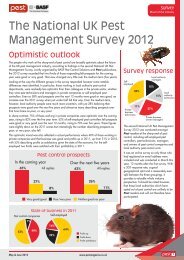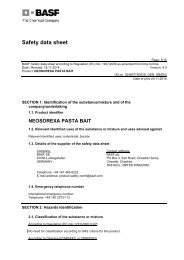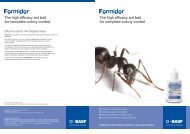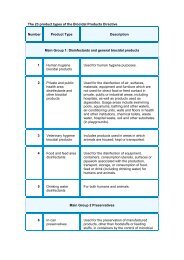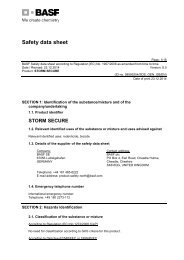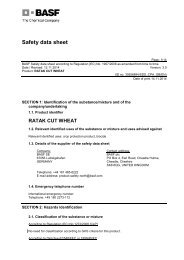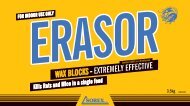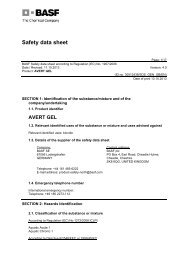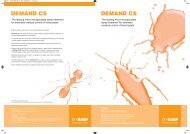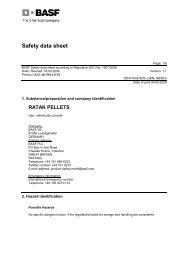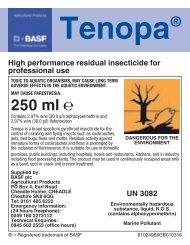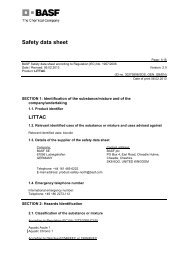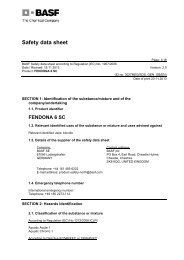Rodent Baiting Record Book. - Pest Control Management - BASF
Rodent Baiting Record Book. - Pest Control Management - BASF
Rodent Baiting Record Book. - Pest Control Management - BASF
You also want an ePaper? Increase the reach of your titles
YUMPU automatically turns print PDFs into web optimized ePapers that Google loves.
<strong>Rodent</strong> <strong>Control</strong><br />
<strong>Record</strong> <strong>Book</strong><br />
ON FARM<br />
REPORT<br />
MANUAL<br />
Farm Name:<br />
Date:<br />
Produced in partnership<br />
with FarmTrain<br />
Enabling the most effective solutions to your pest problems.
Developing an Integrated <strong>Rodent</strong> Strategy<br />
This book has been<br />
designed to help you plan<br />
and organise your rodent<br />
control procedures whilst<br />
keeping a record of your<br />
activities.<br />
Good record-keeping is important if you are to:<br />
Comply with food and farm quality<br />
assurance schemes.<br />
Apply the appropriate treatment to the<br />
given situation.<br />
Ensure the most effective bait point siting.<br />
Maintain consistent bait replenishment.<br />
Monitor the success of treatments.<br />
Demonstrate sufficient wildlife responsibility.<br />
Any good rodent control plan should constantly go through 3<br />
stages: Preventative, Non Chemical solutions and <strong>Baiting</strong>.<br />
By eliminating key rat and mouse necessities such as food<br />
and harbourage and constantly searching for rodent activity<br />
your control strategy becomes easier to manage and makes<br />
infestations more preventable.<br />
Monitoring and <strong>Record</strong>ing<br />
Preventative<br />
Non-Chemical<br />
<strong>Baiting</strong><br />
Monitoring and <strong>Record</strong>ing<br />
Habitat <strong>Management</strong><br />
Eliminate and<br />
Reduce Opportunity<br />
Food<br />
Harbourage<br />
Aim to<br />
PREVENT<br />
activity in the<br />
first place.<br />
Frequently<br />
Monitor<br />
Look for signs of activity:<br />
Sightings<br />
Droppings<br />
Damage<br />
Tracks<br />
This useful cycle of eliminating opportunities and frequent monitoring will reduce<br />
the potential impact of a rodent infestation on your farm. Being vigilant to the<br />
signs that rodents are present, as well as minimising the chances they have to<br />
access food and shelter, will help prevent rodents from settling in to the habitat.<br />
If during monitoring you do spot signs of rodent activity, analyse the location and<br />
decide on the best course of treatment for an eradication campaign. Be sure<br />
not to significantly modify the site before your treatment begins, for example<br />
removing rodent harbourage, as this will disturb the infestation making control<br />
more difficult to achieve.<br />
2
ERADICATION CAMPAIGN<br />
If an infestation has been identified, consider and eliminate the<br />
different control options available, taking care not to adversely<br />
affect the surrounding environment and non-target species.<br />
PREVENTATIVE<br />
Hygiene Issues - Minimise rodent access to alternative food sources<br />
Store grain and feed in secure areas behind closed doors.<br />
Block up any obvious rodent access points.<br />
Fit metal strips to the base of gnawed wooden doors.<br />
Clear-up all spilled grain and feed.<br />
Readily-available alternative food access can seriously restrict bait uptake.<br />
NON-CHEMICAL<br />
Traps are an important part of an Integrated <strong>Rodent</strong> Strategy and they come in<br />
different shapes, sizes, and types. They can also be used to help to identify the pest<br />
problem and for quick knock down of populations or problem rats and mice. Please<br />
always refer to user guidelines for the use and checking of traps.<br />
Non Toxic monitoring baits - for use to identify hotspots, re-invasion and presence of<br />
rats or mice without using chemical baits. Non toxic baits can be used in everyday<br />
baiting to immediately identify activity so they can then be substituted with a chemical<br />
bait for your eradication campaign.<br />
BAITING<br />
1st Generation baits (for rats)<br />
Acutes (for mice)<br />
Gassing (for rats) away from buildings<br />
Second Generation Anticoagulants (SGARs) -<br />
(for rats and mice) in and around buildings<br />
Place baiting points whenever<br />
you spot signs of rodent<br />
activity<br />
Along rat runs beside walls between<br />
living and feeding areas.<br />
Where tell-tale droppings, gnawing,<br />
footprints, smears are evident.<br />
In holes and burrows.<br />
Extending beyond obvious hot<br />
spots to ensure full farmstead<br />
control.<br />
The more the better, especially with<br />
mouse infestations.<br />
To overcome rat neophobia site<br />
baiting points several days before<br />
putting out the bait.<br />
Replenish Neosorexa ® and<br />
Sorexa ® baits regularly<br />
Inspect bait points every day for the<br />
first 3 or 4 days.<br />
Then check every 3-4 days.<br />
Replenish all eaten bait on every<br />
occasion.<br />
Where bait remains untouched after a<br />
week re-site the point.<br />
Maintain baiting until all signs of<br />
consumption and activity have<br />
ceased.<br />
Clear-up and dispose of all uneaten<br />
bait and any dead rodents after<br />
treatment.<br />
Campaigns should last no longer<br />
than 35 days.<br />
Because rodents may need several<br />
feeds to acquire a lethal dose<br />
of difenacoum, baits need to be<br />
continuously available in sufficient<br />
quantity. See product labels for details.<br />
Provide Storm ® flocoumafen<br />
baits in strict weekly pulses<br />
Only use indoors.<br />
Inspect bait points 3, 7 and 14 days<br />
after initial treatment.<br />
Replenish all eaten bait on each<br />
occasion.<br />
Where bait remains untouched resite<br />
the point.<br />
Clear-up all uneaten bait and any<br />
dead rodents after 21 days.<br />
Because rodents will consume a lethal<br />
dose of flocoumafen in a single feed,<br />
pulse baiting allows significant savings<br />
in both bait use and treatment time.<br />
See product labels for details.<br />
Eradicate activity quickly and efficiently. Remove all baits at the end of a campaign and search for bodies.<br />
3
Responsible Farm <strong>Rodent</strong> Planning - Outside<br />
1<br />
Remove rubbish and<br />
clean-up site, to prevent<br />
areas for rats to live in and<br />
move around under.<br />
2<br />
Prevent rodent ingress<br />
under doors. Fix kicker<br />
plates, re-hang door or<br />
change the floor – just<br />
keep them out!!<br />
3<br />
Cut back vegetation close<br />
to a building to remove<br />
cover for rodents to<br />
migrate from one place<br />
to another and around<br />
buildings.<br />
4<br />
All spilt food should be<br />
cleaned up immediately it<br />
occurs. This is an alternative<br />
food source to your<br />
rodenticides and will effect<br />
how quickly you get bait<br />
take and therefore control.<br />
5<br />
Burrow bait where obvious<br />
active rat burrows appear.<br />
Use Neosorexa ® Gold or<br />
Neosorexa ® Bait Blocks<br />
directly into hole and then<br />
heal in soil to cover bait.<br />
Check bait daily.<br />
6<br />
Where evidence of rat activity<br />
is found use either Neosorexa ®<br />
Gold or a secureable product<br />
such as Neosorexa ® Pasta or<br />
Bait blocks. Always cover bait<br />
and protect from non target<br />
species. You may use suitable<br />
materials on site or the Roguard<br />
bait station or Wide Piper offer<br />
more secured bait points where<br />
necessary.<br />
4
Responsible Farm <strong>Rodent</strong> Planning - Inside<br />
1<br />
Ensure all food rubbish<br />
is removed from site (for<br />
example: discarded boxes<br />
and containers, over<br />
spill from rubbish bins,<br />
discarded animal feed bags<br />
etc).<br />
2<br />
Spilt food and nesting<br />
material must be frequently<br />
removed to reduce<br />
possible activity becoming<br />
established.<br />
3<br />
For quick results start<br />
mouse control using snap<br />
traps.<br />
For 100% control the use<br />
of rodenticides may be<br />
required.<br />
4<br />
Signs such as heavy smear<br />
marks over the containers<br />
and bags, along with<br />
packaging damage on the<br />
cardboard boxes clearly<br />
show high mouse activity in<br />
the area.<br />
5<br />
Mouse droppings found<br />
on stored items should<br />
be cleared away to allow<br />
ongoing monitoring.<br />
6<br />
Where evidence of mouse<br />
activity is found place<br />
Sorexa ® D, Sorexa ® Gel or<br />
Storm ® baits in a secure<br />
baiting station and inspect<br />
in accordance with the<br />
product label.<br />
5
<strong>Record</strong> Keeping And Due Diligence<br />
Bitte benutzen Sie für Ihre Skizze die folgenden Symbole:<br />
Gebäude<br />
Tür // Tor Tierhaltung Futterlager<br />
Wasser<br />
Area Key<br />
Bitte Bitte benutzen Building benutzen Sie Sie für Sie für Ihre für Door/Gate Ihre Skizze Skizze die die folgenden die folgenden Livestock Symbole:<br />
Symbole:<br />
Feed<br />
Gebäude<br />
Gebäude<br />
Tür Tür / Tür Tor / Tor / Tor Tierhaltung Tierhaltung Futterlager<br />
Futterlager<br />
storage<br />
Water Wetland Path Stack<br />
Wasser<br />
Wasser<br />
Feuchtgebiet Kanal ( straw / hay )<br />
Stapel (Stroh // Heu)<br />
Rattenbau<br />
Köderstation<br />
tte benutzen Sie für Ihre Skizze die folgenden Symbole:<br />
Gebäude<br />
Tür / Tor Tierhaltung Futterlager<br />
Wasser<br />
Feuchtgebiet Feuchtgebiet Kanal Kanal Stapel Stapel (Stroh (Stroh / Heu) / / Heu)<br />
Rattenbau<br />
Rattenbau<br />
Köderstation<br />
Köderstation<br />
<strong>Rodent</strong> Key<br />
<strong>Rodent</strong><br />
burrow<br />
uchtgebiet Kanal Stapel (Stroh / Heu) Rattenbau<br />
Bait<br />
station<br />
Köderstation<br />
Rat<br />
activity<br />
Mouse<br />
activity<br />
<strong>Rodent</strong><br />
entry point<br />
Non-target<br />
activity<br />
Gebäude Gebäude<br />
Your Outdoor Farm Plan<br />
Bitte benutzen Bitte benutzen Sie für Sie Ihre für Skizze Ihre Skizze die folgenden die folgenden Symbole: Symbole:<br />
Tür / TorTür / Tor Tierhaltung Tierhaltung Futterlager Futterlager<br />
Wasser Wasser<br />
Feuchtgebiet Feuchtgebiet Kanal Kanal Stapel (Stroh Stapel /(Stroh Heu) / Heu) Rattenbau Rattenbau Köderstation Köderstation<br />
6
Draw on here your outdoor and indoor areas for rodent control. Highlight key<br />
areas of activity and where you plan to use bait stations for your eradication<br />
campaign. Number your bait stations/traps on the diagram for the table overleaf.<br />
Also mark where any specific non-target species activity is seen and special care<br />
is needed.<br />
Your Indoor Plan<br />
7
<strong>Rodent</strong> Eradication Campaign<br />
Name of responsible person(s):<br />
Campaign 1 Start Date: DD/MM/YYYY<br />
No. Location<br />
Product<br />
Type<br />
<strong>Pest</strong><br />
Type<br />
Start Date Total Quantity<br />
Second<br />
Application<br />
Total Quantity<br />
Third<br />
Application<br />
Total Quantity<br />
Final<br />
Application<br />
1 Barn Door<br />
Neosorexa<br />
Gold<br />
Rats 10/5/15 200g 15/10/15 100g 20/10/15 100g 25/10/15 0g<br />
Quantity
Campaign 2 Start Date: DD/MM/YYYY<br />
Name of responsible person(s):<br />
No. Location<br />
Product<br />
Type<br />
<strong>Pest</strong><br />
Type<br />
Start Date Total Quantity<br />
Second<br />
Application<br />
Total Quantity<br />
Third<br />
Application<br />
Total Quantity<br />
Final<br />
Application<br />
Quantity<br />
1 Barn Door<br />
Neosorexa<br />
Gold<br />
Rats 10/5/15 200g 15/10/15 100g 20/10/15 100g 25/10/15 0g
Campaign 3 Start Date: DD/MM/YYYY<br />
Name of responsible person(s):<br />
No. Location<br />
Product<br />
Type<br />
<strong>Pest</strong><br />
Type<br />
Start Date Total Quantity<br />
Second<br />
Application<br />
Total Quantity<br />
Third<br />
Application<br />
Total Quantity<br />
Final<br />
Application<br />
Quantity<br />
1 Barn Door<br />
Neosorexa<br />
Gold<br />
Rats 10/5/15 200g 15/10/15 100g 20/10/15 100g 25/10/15 0g
Campaign 4 Start Date: DD/MM/YYYY<br />
Name of responsible person(s):<br />
No. Location<br />
Product<br />
Type<br />
<strong>Pest</strong><br />
Type<br />
Start Date Total Quantity<br />
Second<br />
Application<br />
Total Quantity<br />
Third<br />
Application<br />
Total Quantity<br />
Final<br />
Application<br />
Quantity<br />
1 Barn Door<br />
Neosorexa<br />
Gold<br />
Rats 10/5/15 200g 15/10/15 100g 20/10/15 100g 25/10/15 0g
Campaign 5 Start Date: DD/MM/YYYY<br />
Name of responsible person(s):<br />
No. Location<br />
Product<br />
Type<br />
<strong>Pest</strong><br />
Type<br />
Start Date Total Quantity<br />
Second<br />
Application<br />
Total Quantity<br />
Third<br />
Application<br />
Total Quantity<br />
Final<br />
Application<br />
Quantity<br />
1 Barn Door<br />
Neosorexa<br />
Gold<br />
Rats 10/5/15 200g 15/10/15 100g 20/10/15 100g 25/10/15 0g
Campaign 6 Start Date: DD/MM/YYYY<br />
Name of responsible person(s):<br />
No. Location<br />
Product<br />
Type<br />
<strong>Pest</strong><br />
Type<br />
Start Date Total Quantity<br />
Second<br />
Application<br />
Total Quantity<br />
Third<br />
Application<br />
Total Quantity<br />
Final<br />
Application<br />
Quantity<br />
1 Barn Door<br />
Neosorexa<br />
Gold<br />
Rats 10/5/15 200g 15/10/15 100g 20/10/15 100g 25/10/15 0g
The Best Bait Choices For Your Eradication Campaign<br />
Neosorexa ® Gold<br />
The UK’s No 1 rat and mouse bait with Fortec<br />
technology for increased bait consumption.<br />
The UK’s<br />
No1<br />
<strong>Rodent</strong>icide<br />
Multi-purpose, cut wheat bait for effective and consistent control<br />
Extremely palatable with Fortec technology for increased bait consumption<br />
A lethal dose consumed within just one day<br />
Proven superior performance to ordinary baits<br />
Available as loose bait or 100g sachets<br />
Containing difenacoum, Neosorexa ® Gold is the first rodent bait to use the patented<br />
Fortec technology. A mixture of foraging grain pellets and cut wheat means greater<br />
palatability and faster control of rats and mice.<br />
What is Fortec?<br />
A major advancement in rodenticide technology<br />
to aid modern rodent control. Fortec introduces<br />
a ‘new approach’ to rat management, offering<br />
more rapid and reliable control by exploiting<br />
rats’ natural feeding behaviour.<br />
Touch<br />
Taste<br />
Sight<br />
Smell<br />
14
Neosorexa ® Blocks<br />
The most reliable multi<br />
feed block bait for rat and<br />
mouse control. Provides the<br />
best balance of palatability<br />
and durability in a highly<br />
efficacious block.<br />
Neosorexa ® Pasta Bait<br />
The most reliable multi<br />
feed pasta bait for difficultto-control<br />
rats and mice.<br />
Provides a moist, rich bait in a<br />
highly palatable and attractive<br />
formulation.<br />
Sorexa ® D<br />
The ultimate canary seed bait<br />
for mouse control. Provides<br />
maximum uptake by mice in<br />
any situation.<br />
Sorexa ® Gel<br />
The preferred mouse gel<br />
bait for hard to reach areas.<br />
Provides targeted application<br />
of a specialist mouse<br />
formulation in sensitive<br />
environments.<br />
Storm ® Secure<br />
The fastest single feed,<br />
fixable block bait for indoor<br />
rat and mouse control.<br />
The Best Bait Stations<br />
Secure bait stations are an important way of minimising<br />
the risk of rodenticides to children, pets and other nontarget<br />
species.<br />
Designed with a clear understanding of natural rodent<br />
behaviour, Roguard ® bait stations do this while also<br />
minimising the extent to which bait boxes restrict the<br />
uptake of rodenticides by rats in particular.<br />
Use the Roguard ® Xtra for the greatest versatility<br />
Twin feeding chambers equally suited to any bait type –<br />
or a rat trap.<br />
Sufficient space to accommodate more than one rat at<br />
a time.<br />
Strong and robust with tamper-resistant locks and<br />
multiple anchorage points.<br />
Use the Roguard ® Wide Piper for grain baiting<br />
simplicity<br />
Heavy duty, gravity-fed dispenser in a pipe form familiar<br />
to rats.<br />
Designed for all grain baits.<br />
Clear bait hopper allows rapid visual consumption check.<br />
15
A sociation members in 2010.<br />
around their farm.<br />
In and around<br />
maize silage clamps<br />
In and around hay<br />
or straw stacks<br />
Around muck<br />
or slurry vstores<br />
In f ed passages<br />
and feeding areas<br />
In and around<br />
concentrate<br />
storage areas<br />
In and around<br />
mill and mix areas<br />
13%<br />
The Key <strong>Control</strong> Cha lenge<br />
5%<br />
44%<br />
38%<br />
31%<br />
Source o figure:<br />
National maize silage study conducted with members of the Maize Growers A sociation<br />
the silage to drink.<br />
where infestations are maize silage-based.<br />
Use biocide safely. Always read the label and product information before use.<br />
Further information from:<br />
Far le s predictable rodent problems brought on by<br />
much more variable seasons coupled with growing<br />
food safety and farm a surance requirements make<br />
it vital to keep on top of rats and mice in and around<br />
grain stores from as soon after harvest as po sible.<br />
Repairs to gu ters, d ors and fl ors wi l, however, help restrict a ce s.<br />
Equa ly, removing ru bish and scrub for about a metre around grain stores<br />
removes local rat harbourages and discourages their a proach.<br />
Bait containers are best sited down the outsides of buildings where<br />
rats tend to concentrate their travel and should be insta led we l before<br />
pu ting down the bai to help overcome their natural warine s of new<br />
things. Secure bait points should also be placed strategica ly inside stores<br />
to intercept both rats and mice.<br />
Large amounts of stored grain in highly a ce sible barns are a magnet<br />
fo rats and mice. As their external f od sources are depleted and once<br />
the disturbance of harvest subsides, rats increasingly come in from the<br />
With such a ready source o f od on hand, it is vital to use an especia ly<br />
fields to forage in and around grain stores.<br />
palatable bai to ensure sufficiently early and complete uptake fo rapid<br />
In contras to rats which live in external bu rows and only visit grain<br />
and e fective control.<br />
stores to f ed, mice establish colonies within the buildings themselves Since single f ed rodenticides can’t be used outd ors in the UK,<br />
and may never venture outside.<br />
the best external rat baiting options is Neosorexa ® Gold with patented<br />
Although they are responsible for 25% of a l farm fires, grain contamination Fortec TM technology based on difenacoum-treated cut and whole wheat<br />
is the main risk from rodent infestations. Each rat produces around 15, 0 respectively.<br />
dro pings and 6 litres of urine a year. And mice typica ly produce around Both these advanced foraging grain formulations are proven to<br />
30, 0 dro pings and a litre of urine per head per year.<br />
overcome bait shyne s and stimulate enhanced levels of immediate intake<br />
With rodents known to ca ry a wide range of human and animal<br />
that can make the multi-f ed rodenticide deadly in a day.<br />
diseases – including cryptosporidiosis, toxoplasmosis, leptospirosis, They also have the advantage o familiarity to rodents f eding on grain.<br />
bruce losis and salmone losis – preventing such contamination is a f od Specialist pasta, canary s ed or gel baits based on difenacoum are<br />
and f ed safety as much as quality e sential.<br />
also recommended for ind or mouse control given the rodenticide’s<br />
Rat infestation pa terns, in particular, becoming as increasingly<br />
particular potency against mice. And where populations prove particularly<br />
unpredictable as the climate. Sometimes there is li tle, if any, evidence cha lenging single-f ed Storm ® Secure blocks based on flocoumafen<br />
of activity. Then su denly rats s em to be a l over the place, posing<br />
can be a usefu last resort – although legislation means these can<br />
major problems.<br />
only be used inside secure buildings.<br />
In a dition to this clear, climate-linked change, of course, rat and mouse With a l multi-f ed rodenticides it is vital to check and top-up bait<br />
numbers continue to be a l t o easy to seriously under-estimate until containers every two or thr e days until a l signs of rodent activity cease.<br />
they reach very high levels simply because they f ed almost exclusively Failing to provide sufficient bait over a long enough period for even the<br />
at night.<br />
least dominant individuals in a large population to consume a lethal dose<br />
is, after a l, one of the most common reasons for p or control.<br />
Under these circumstances – and with tighter f od quality a surance And br eding rates mean populations can completely re-establish<br />
eds – the traditional fire-brigade a proach to rat and mouse control themselves in li tle more than a month even with 80% control, leading<br />
n eds to be replaced with simple but we l-pla ned routine programmes<br />
to a rapid resurgence of problems.<br />
that both exclude and eliminate rodents from grain storage areas.<br />
Reason to take <strong>Rodent</strong>s Seriously<br />
8%<br />
Take <strong>Control</strong><br />
The Best <strong>Control</strong> Planning<br />
maize silage.<br />
adequately pr ofing most outd or silos.<br />
up to them and around u per clamp shoulders.<br />
alternatives on o fer to ensure sufficient intake.<br />
whole wheat respectively.<br />
Early control, with a cycle of baiting s on after harvest, is vital to<br />
stop rat and mouse populations ge ting established in and around grain<br />
stores. This wi l restrict rodent activity from the start, doing much to<br />
preven the su den winter upsurges that increasingly s em to<br />
characterise modern infestations. With rats being able to ge through a<br />
hole the size of a man’s thumb and mice through even sma ler openings,<br />
total exclusion isn’t practical on most farms. Not least with so many<br />
other demands on sta f time.<br />
re-treatment important.<br />
Neosorexa ® Gold contains difenacoum. Neosorexa ®, Storm® and Fortec<br />
Use biocide safely. Always read the label and product information before use.<br />
Further information from:<br />
<strong>BASF</strong> Plc - Professional and Specialty Solutions,<br />
TM<br />
are registered trademarks of <strong>BASF</strong>.<br />
PO Box 4, Earl Road, Cheadle Hulme, Cheadle, Cheshire, SK8 6QG, United Kingdom<br />
Tel: 0161 485 6 2 Fax: 0161 485 1137 e-mail: pestinfo@basf.com www.pestcontrol.basf.co.uk<br />
The Best <strong>Rodent</strong>icide Practice<br />
NOTE 2<br />
02 03 - Advice Notes A4 ver2 Lft.in d 1 02/12/2014 16:02:14<br />
Campaign for Responsible <strong>Rodent</strong>icide Use<br />
Always have a planned<br />
approach.<br />
Always read the label.<br />
Always record quantity of bait<br />
used and where it is placed.<br />
Always use enough baiting<br />
points.<br />
Always collect and dispose of<br />
rodent bodies.<br />
Never leave bait exposed to<br />
non-target animals and birds.<br />
Never fail to inspect bait<br />
regularly.<br />
Never leave bait down at the<br />
end of the treatment.<br />
<strong>BASF</strong> Supports<br />
Further Information and Support<br />
Visit www.pestcontrol.basf.co.uk/go/diytips<br />
for simple pest control knowhow.<br />
Content includes:<br />
• Advice Notes on <strong>Rodent</strong> <strong>Baiting</strong> in Grain Stores, <strong>Rodent</strong> <strong>Baiting</strong> in Maize Silage,<br />
Milking Cluster Disinfection and <strong>Control</strong>ling Mice in Intensive Livestock Units.<br />
• Storm ® User Guide.<br />
• <strong>Baiting</strong> <strong>Record</strong> <strong>Book</strong>.<br />
• Sorgene ® 5 User Guide - Disinfectant for livestock and general farm use.<br />
• Best Practice Dairy Calving Hygiene Smart Guide.<br />
• <strong>Rodent</strong>icide Decider to help you choose the right rodenticide for your specific<br />
situation.<br />
Online technical support:<br />
Think Rat Resource - to help plan control programmes to take the greatest<br />
advantage of natural rodent behaviour.<br />
Interactive Video Guides - to help save treatment time through the best control<br />
practice in a range of ‘real life’ situations.<br />
Contro ling Rats in Maize Silage<br />
Maize silage presents particula rat control<br />
challenges on many livestock farms. Indeed, over<br />
80% of maize growers acro s England & Wales<br />
reported greater rat problems a sociated with<br />
their maize clamps than elsewhere on the farm in<br />
a national study conducted with Maize Growers<br />
Contro ling Rats and Mice<br />
Around Grain Stores<br />
Pla ning and managing rodenticide baiting to take maximum<br />
advantage of the way rats are behaving is e sential if e fective<br />
control is to be achieved despite the unique cha lenge presented by<br />
Since the rats commonly live within the clamps themselves, the first<br />
e sential has to be to intercept as many adults as po sible before<br />
they take up residence and become far le s a ce sible.<br />
A the same time, many more report encountering rats in and<br />
around their maize clamps than in other typical rodent hot spots<br />
This is particularly important given the near impo sibility of<br />
In most seasons rats are already starting to move in from the fields<br />
in search of winter a commodation by the time maize silage is<br />
clamped in the late autumn. So sufficient baiting points should be incorporated<br />
in their immediate vicinity of the clamps and baited with<br />
rodenticides as s on as they are securely sh eted down.<br />
A generous number of baiting points n ed to be sited where rats<br />
commonly s ek a ce s – along a l silage faces, internal wa ls ru ning<br />
We l-sited baiting points wi l, of course, also ensure the best winter long<br />
interception of rats as they leave the clamps in search of water<br />
which they are physiologica ly unable to obtain from f ed alone.<br />
The particular a peal of maize silage as a f odstu f as we l as<br />
a commodation makes it vital to employ the most a resting and<br />
a tractive rodenticide bait. After a l, if rats are only consuming sma l<br />
amounts of other f eds, baits n ed to be the most a tractive<br />
Since single f ed rodenticides can’t be used outd ors in the UK, the<br />
The r ot of the cha lenge is made clear by the fac tha two thirds<br />
best baiting options are Neosorexa Gold or Neoki l Gold with their<br />
of those encountering rats in and around their maize silage actua ly patented Fortec technology based on difenacoum-treated cut and<br />
repor them within the clamps. Here they find such a secure, relatively<br />
dry and energy rich environmen tha they often only n ed to leave<br />
Both these advanced foraging grain formulations are proven to<br />
overcome bait shyne s and stimulate enhanced levels of immediate<br />
It is hardly surprising, therefore, that many livestock units can<br />
intake that make the multi-f ed rodenticide deadly in a day.<br />
experience disa pointing levels of control with rodenticide baits<br />
A l maize clamp baiting points n ed to be we l to ped-up initia ly and<br />
wheneve rats are s en around the farm. Unle s refi led every two or<br />
Thr e quarters of those participating in the 2010 study,<br />
thr e days during treatment, bait levels can easily be depleted before<br />
ind ed, pinpointed rats living inside the clamps as the main reason a l the rats have had the chance to consume a lethal rodenticide<br />
for particular problems a sociated with maize silage, with two thirds dose. Equa ly, as a particularly a tractive environment, maize silage<br />
finding that rats often prefer maize to thei rodenticide baits.<br />
remains a magnet fo re-infestation by othe rat populations in the<br />
area once control has eliminated the competition, making regular<br />
Although su gested by a minority of growers in the study, rodenticide<br />
resistance is only likely to be an i sue in the few distinct areas where<br />
it is already known to exist; especia ly so as the latest research shows Practical work with farmers acro s the country confirms that<br />
that Vitamin K levels far higher than those found in the richest of<br />
constant vigilance and the best po sible rodenticide practice based<br />
known forage sources are required for any antidotal e fect agains the on a thorough understanding of rat behaviour is invariably more than<br />
most widely-used modern farm rodenticide, difenacoum.<br />
enough to k ep even maize-based problems we l under control.<br />
Where do you mainly encounte rat problems?<br />
<strong>BASF</strong> Plc - Profe sional and Specialty Solutions,<br />
The Best <strong>Rodent</strong>icide Practice<br />
PO Box 4, Earl Road, Cheadle Hulme, Cheadle, Cheshire, SK8 6QG, United Kingdom<br />
Tel: 0161 485 6222 Fax: 0161 485 137 e-mail: pestinfo@basf.com www.pestcontrol.basf.co.uk<br />
ADVICE<br />
NOTE 1<br />
02 03 - Advice Notes A4 ver1 Lft.in d 1 02/12/2014 16:02: 4<br />
Storm ® Secure<br />
The fast single feed, fixable<br />
block bait for indoo rat and<br />
mouse control.<br />
The fast way to eliminate rodent infestations<br />
Delivers a lethal dose in a single feed<br />
Saves time and money in application<br />
Effective even against resistant strains<br />
Enabling the most e fective solutions to your pest problems.<br />
USER<br />
GUIDE<br />
02 02 - <strong>BASF</strong> Storm User Guide UK A5 v2.in d 1 02/12/2014 15:50:11<br />
ADVICE<br />
Advice Notes<br />
Storm ® Secure, <strong>Baiting</strong> <strong>Record</strong> <strong>Book</strong><br />
and Sorgene ® 5 User Guide<br />
Produced in partnership with<br />
FarmTrain:<br />
www.farmtrain.co.uk<br />
info@farmtrain.co.uk<br />
01453 300 300<br />
Neosorexa ® , Sorexa ® , Storm ® , Fortec TM and Roguard ® are trademarks of <strong>BASF</strong><br />
Neosorexa ® and Sorexa ® contain difenacoum. Storm ® contains flocoumafen. Use biocides safely.<br />
Always read the label and product information before use.<br />
Further information from:<br />
<strong>BASF</strong> Plc<br />
PO Box 4, Earl Road, Cheadle Hulme, Cheadle, Cheshire, SK8 6QG<br />
Tel: 0161 488 5355 Fax: 0161 485 1137 Email: pestinfo@basf.com<br />
www.pestcontrol.basf.co.uk




